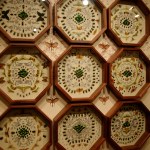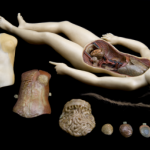museum
tags: Walk-Through of NYC's American Museum of Natural History, museum, natural history museum, AMNH, American Museum of Natural History, NYC, New York City, culture, edutainment, streaming video
This is a rather nice video with a home-made feel to it. It presents a quick view of the American Museum of Natural History in New York, starting on the subway platform (filled with lots of beautiful tile art, all of which I've photographed and shared on my blog). (I noticed that they seem to have finished refurbishing their Indians of the Pacific Northwet exhibit).
The AMNH is a scientific…
Disclaimer: I write the following post as a private citizen. Even though I am a research associate at the museum, my work is done on a volunteer basis in cooperation with museum staff. I am not employed by the museum, and my views do not necessarily represent those of any New Jersey State Museum employee.
After months of uncertainty, the short-term fate of the New Jersey State Museum has finally been revealed. Despite plans proposed by Republican governor Chris Christie that the museum (along with the State Library and Thomas Edison College) be folded into Rutgers University, it was recently…
I'll be the first to admit it; the specimen was not much to look at. Seventy years after being dug out of the ground much of it had crumbled into four-foot-long Y, and the curved teeth that once stood upright in that jaw had slumped out of their sockets into the sulfur-smelling debris. All the same, it was an impressive sight.
During the past four years I have spent much of my free time reading about evolution and paleontology. Popular summaries, symposium volumes, technical papers; the numerous books that clutter my office and the disorganized mess of PDFs on my hard drive have taught me…
The mount of a musk ox (Ovibos moschatus), photographed at the New Jersey State Museum.
A jar full of dogfish, photographed at the New Jersey State Museum.
The preserved head of a California sea lion (Zalophus californianus), dissected and dyed to show some of the glands inside the head. From the collections of the New Jersey State Museum (originally from the College of New Jersey).
The drawers of the world's museums are full of pinned, preserved and catalogued insects. These collections are more than just graveyards - they are a record of evolutionary battles waged between animals and their parasites. Today, these long-dead specimens act as "silent witnesses of evolutionary change", willing to tell their story to any biologist who knows the right question to ask.
This time round, the biologist was Emily Hornett, currently at UCL, and her question was "How have the ratios of male butterflies to female ones changed over time?" You would think that the sex ratios of…
Not the best title for a post, and by best, I mean most accurate. If you'd like to get to the bottom of it, though, try this new dispatch over at McSweeney's: "The Elevator to Room 1028." It has elevators. It has intrigue. It has secrecy. It has stacks of books. And it has elevators.
This is part two of "Days at the Museum." Part I was noted here. It had a better picture.
Joanna of Morbid Anatomy is on a quest to locate private collections of medical oddities. She's already sussed out fourteen such hidden wunderkammern and photographed their treasures, but she wants to find more:
"Who are these private collectors, and what sort of treasures do they possess? How might their methods of displaying collections differ from institutional approaches? Are we reaching a historical moment similar to the pre-museum era of private cabinets, in which the most interesting artifacts are now in private rather than public hands?"
It's a really interesting question.…
Curious Expeditions has a great interview with Jennifer Angus, the artist who recently redecorated the Newark Museum's Victorian Ballentine House with dead insects in an installation called "Insecta Fantasia." Wow!
The Museum restored the elegant abode to its original dark wood and horror vaccui (fear of empty space) style. This fear of empty space is often seen in Victorian homes - pictures covering every inch of wall, furniture and carpets covering all available floor space, murals and moulding on the ceilings, objects crowding every surface, elaborate window coverings and stained glass in…
Below, the "jugum penis," designed to prevent "nocturnal lincontinence" (aka masturbation). One of many wonders in a new London Science Museum online exhibit of historical medical objects called "Brought to Life," as featured in this New Scientist photo essay.
Don't try these at home.
Wax anatomical figure of reclining woman, Florence, Italy, 1771-1800
Science Museum London
Starting today, the Wellcome Trust and sciencemuseum.org.uk open a brand spanking new collection of medical history archives. "Brought to Life: Exploring the History of Medicine" is searchable by people, place, thing, theme, and time. You can view a timeline of medical history in Europe next to similar timelines for the Islamic empire, Egypt and Greece (I do wish China and India were as prominently placed). You can read essays about larger questions, like what "wellness" means, or play with a cool…
tags: Luonnontieteellinen museo Helsinki, Helsinki Museum of Natural History, diorama, education, construction, streaming video
This streaming video is a time-lapse documentation of construction of the bear diorama at the Luonnontieteellinen museo Helsinki (Helsinki Natural History Museum) [7:42].
Suomi: Karhudioraamaa rakennetaan Helsingin Luonnontieteelliseen museon Suomen luonto -näyttelyyn keväällä 2008. Seppo Polameri tekee aluksi taustamaalauksen, jonka jälkeen konservaattorit tuovat paikalle täytetyt karhut ja muut eläimet sekä viimeistelevät dioraaman. Rakentaminen kesti…
The fiberglass skull of Barnum Brown's second Tyrannosaurus rex fitted on the revised mount now standing on the 4th floor of the AMNH.
The AMNH in New York is home to some of the most impressive biological collections in the world, the institution playing host to various students of natural history. This tradition of allowing researchers and graduate student access to the collections is now taking another step forward with the opening of the Richard Gilder Graduate School, currently offering a Ph.D. in Comparative Biology. As the "Welcome" statement from John J. Flynn states, much of…
A close-up B&W shot of the Willamette Meteorite. The holes the riddle one face of the meteorite were not caused by "cosmic collisions" but by the bolide rusting away in the ground prior to its removal from the Oregon soil (it consists of 91% iron).
Virginia Hughes is an editorial assistant here at ScienceBlogs who was especially helpful in moving Laelaps over to it's new home, and now she's brought her excellent writing to The Gist on Smithsonian.com. The first story? A 30-pound hunk of the Willamette Meteorite appraised at $1.3 million was withdrawn from auction after it failed to…
Happy Halloween, everyone! In searching for a somewhat frightening image (I already recently used Prestosuchus and Amphicyon), I recalled this photo of the AMNH Tyrannosaurus rex mount. Most of the photos I have of the reconstruction are of the whole head or body, but I especially like this one for far more subtle reasons; the close-up makes it appear as if the dinosaur is just beginning to open its jaws, my imagination filling in the sound of heavy breaths escaping the cavernous tooth-lined maw.
Yesterday my friend Julia commented that one of the best times to visit a museum is in the late afternoon during the winter, and these two photographs will give you some idea why. While the fourth floor of the AMNH is usually bathed in natural lighting during most of the day and artificial lighting from above during the evening, there's a few minutes during the winter months while the sun is getting low in the sky but the overhead illumination hasn't come on yet, a time when shadows sweep across the ancient bones. These two photographs of the "Bear Dog" Amphicyon were taken during that short…
This past week I managed to read Peter Dodson's very helpful book The Horned Dinosaurs from cover-to-cover (in addition to finishing some books on Megalania, dinosaur reproduction, philosophy, etc. A massive book review is forthcoming), one of my most favorite sections being where Dodson walks the reader through reconstructing a Chasmosaurus skeleton bone-by-bone. Oddly enough, I came across the a YouTube video of a self-assembling Chasmosaurus skeleton (embedding was disabled for this video), although unfortunately for curators I have not known skeletons to acquiesce to fully leaving their…
tags: Smithsonian Institution, National Zoo, museum, funding crisis
What's wrong with this picture: America is spending billions and billions of dollars to bomb the snot out of Iraq, but we can't even spare a fraction of that cost to fix our premier museum and zoo??
According to a news story that appeared in today's Washington Post, the Smithsonian Institution and the National Zoo are rapidly deteriorating due to a lack of funds to repair and update the facilities and to hire enough security guards to protect this nation's historic treasures.
Deteriorating Smithsonian facilities have…


